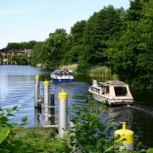
Eberswalde
The town of Eberswalde, located just 50 km north-east of Berlin, can look back at a long tradition of forestry and forest related research. On these traditional grounds the University of Applied Sciences was founded in 1992. With about 1800 students it is the smallest university of applied sciences in the state of Brandenburg.The city of about 42.000 inhabitants and was founded in the 13th century. Two copper factories and the first paper mill of the Mark Brandenburg were the basis for the first urban industry in 1532. The economic upturn of the city was strengthened by the construction of the Finow Canal, the first artificial connection between two streams in Germany at that time. During the Thirty Years’ War the Finow Canal was destroyed and the local industry suffered. In 1743 Friedrich II. gave order to restore the former connection between the rivers Havel and Oder and as a result the 2nd Finow Canal became the lifeline of the region. During the Second World War the historic town centre was destroyed by the German air force. Not until 1992 the decision was made to restore the historic buildings.Since 1990 the economy has been diversified by the main businesses branches: automotive, renewable energy, trade, tourism and health. The core sectors of the local industry are: automotive, food, wood processing industry, plastics / chemicals, logistics, metal and paper industry, rail transportation equipment and energy. Trough the realignment of its support policy in 2005, the state of Brandenburg has classified the town of Eberswalde as a regional development centre and allocated funds accordingly. Currently nearly 2000 small and medium-sized enterprises are located in Eberswalde.
• Better cooperation between the city and the university
• Marketing the city as a place of higher educational for
institutions and innovative firms.
• Enhancing the living conditions and infrastructure (in order to reduce commuting by students and
employees)
• To create concepts to adapt infrastructure (e.g. for wastewater disposal lines) to demographic
change
• To act instead of react within the urban redevelopment design process
SOME RELATED NETWORKS
OP-ACT
OP-ACT
Options of actions - strategic positioning of small and medium sized cities Demographic change, advanced de-industrialization and the current...
